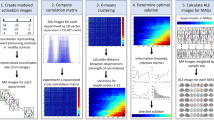Abstract
A recent paper by Fielding et al. (J Gamb Stud, 2017) argued that the brain’s reward response could occur without the presentation of actual reward. We suggest that since (a) the event-related potentials reported in this paper are atypical of the previous literature, and, (b) a simpler account of the data in terms of sensitivity to outcome frequency cannot be ruled out, the extent to which the brain’s reward response can occur without the presentation of actual reward should remain an open question.




Similar content being viewed by others
References
Abe, H., & Lee, D. (2011). Distributed coding of actual and hypothetical outcomes in the orbital and dorsolateral prefrontal cortex. Neuron, 70, 731–741.
Dyson, B. J., Steward, B. A. & Meneghetti, T. (in preparation). The influence of phasic norepinephrine release on decision making via observation and play.
Fielding, A., Fu, Y., & Franz, E. A. (2017). The brain’s reward response occurs even without actual reward! Journal of Gambling Studies. https://doi.org/10.1007/s10899-017-9721-3.
Forder, L., & Dyson, B. J. (2016). Behavioural and neural modulation of win-stay but not lose-shift strategies as a function of outcome value in rock, paper, scissors. Scientific Reports, 6, 33809.
Frank, M. J., Woroch, B. S., & Curran, T. (2006). Error-related negativity predicts reinforcement learning and conflict biases. Neuron, 47, 495–501.
Gentsch, A., Ullsperger, P., & Ullsperger, M. (2009). Dissociable medial frontal negativities from a common monitoring system for self- and externally caused failure of goal achievement. NeuroImage, 47, 2023–2030.
Guo, F., Hong, B., Gao, X., & Gao, S. (2008). A brain–computer interface using motion-onset visual evoked potential. Journal of Neural Engineering, 5, 477–485.
Hajcak, G., Holroyd, C. B., Moser, J. S., & Simons, R. F. (2005). Brain potentials associated with expected and unexpected good and bad outcomes. Psychophysiology, 42, 161–170.
Hauser, T. U., et al. (2014). The feedback-related negativity (FRN) revisited: New insights into the localization, meaning and network organization. NeuroImage, 84, 159–168.
Heldmann, M., Russeler, J., & Münte, T. F. (2008a). Internal and external information in error processing. BMC Neuroscience, 9, 33.
Heldmann, M., Russeler, J., & Münte, T. F. (2008b). Internal and external information in error processing. BMC Neuroscience, 9, 33.
Holroyd, C. B., Hajcak, G., & Larsen, J. T. (2006). The good, the bad and the neutral: Electrophysiological responses to feedback stimuli. Brain Research, 1105, 93–101.
Holroyd, C. B., Nieuwenhuis, S., Yeung, N., & Cohen, J. D. (2003). Errors in reward prediction are reflected in the event-related brain potential. NeuroReport, 19, 2481–2484.
Holyroyd, C. B., & Krigolson, O. E. (2007). Reward prediction error signals associated with a modified time estimation task. Psychophysiology, 44, 913–917.
Kanwsiher, N., & Wojciulik, E. (2000). Visual attention: Insights from brain imaging. Nature Reviews Neuroscience, 1, 91–100.
Liu, T., Goldberg, L., Gao, S., & Hong, B. (2010). An online brain–computer interface using non-flashing visual evoked potentials. Journal of Neural Engineering, 7, 036003.
Müller, S. V., Möller, J., Rodriguez-Fornells, A., & Münte, T. F. (2006). Brain potentials related to self-generated and external information used for performance monitoring. Clinical Neurophysiology, 116, 63–741.
Polich, J. (2007). Updating P300: An integrative theory of P3a and P3b. Clinical Neurophysiology, 118, 2128–2148.
Author information
Authors and Affiliations
Corresponding author
Ethics declarations
Conflict of interest
The authors declared that they have no conflict of interest.
Ethical Approval
All procedures performed in studies involving human participants were in accordance with the ethical standards of the institutional and/or national research committee (Life Sciences and Psychology Research Ethics Committee [C-REC] at the University of Sussex [ER/BS3001/1] and [ER/BJD21/3]) and with the 1964 Helsinki declaration and its later amendments or comparable ethical standards.
Rights and permissions
About this article
Cite this article
Dyson, B.J., Forder, L. & Sundvall, J. Does the Brain’s Reward Response Occur Even Without Actual Reward? A Response to Fielding et al. (2017). J Gambl Stud 34, 853–861 (2018). https://doi.org/10.1007/s10899-018-9746-2
Published:
Issue Date:
DOI: https://doi.org/10.1007/s10899-018-9746-2




